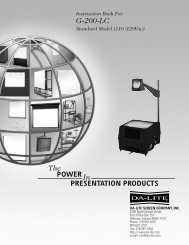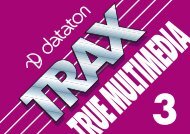Dataton WATCHOUT User's Guide
Dataton WATCHOUT User's Guide
Dataton WATCHOUT User's Guide
You also want an ePaper? Increase the reach of your titles
YUMPU automatically turns print PDFs into web optimized ePapers that Google loves.
The production computer talks to the display computers through the network,<br />
transferring media files for you as required, as well as controlling the playback<br />
of the show.<br />
Display Computers<br />
Network<br />
You need one display computer for each display device (projector, monitor,<br />
etc) used in you presentation. Display computers handle all the hard work<br />
associated with rendering still images and video. They apply edge blends and<br />
playing sound files.<br />
The fact that there’s one computer for each display device makes the system<br />
scalable to virtually any size; as more screens are added, you also add more<br />
computing power to drive these screens.<br />
A fast network ties the parts together, allowing the production computer to<br />
manage all display computers remotely. Once the <strong>WATCHOUT</strong> software has<br />
been installed on the display computers, most vital functions will be managed<br />
over the network.<br />
As you add new media to your presentation, or revise existing media, these<br />
changes are automatically propagated, via the network, to the appropriate<br />
display computers. The network also transfers your display configurations,<br />
timeline programming and other aspects of your presentation to the display<br />
computer. With all this material residing on the display computers, very little<br />
information needs to be sent over the network during playback, avoiding<br />
network congestion.<br />
Chapter 1: Introduction 9




